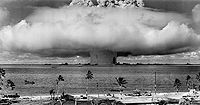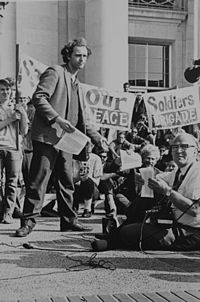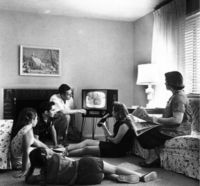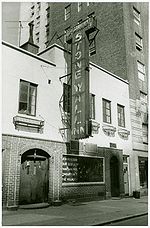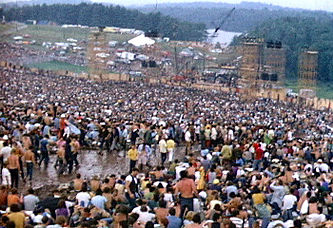- Counterculture of the 1960s
-
 The Peace Sign, designed and first used in Britain in the Campaign for Nuclear Disarmament, became a major symbol of the counterculture era
The Peace Sign, designed and first used in Britain in the Campaign for Nuclear Disarmament, became a major symbol of the counterculture era
The counterculture of the 1960s refers to a cultural movement that mainly developed in the United States and spread throughout much of the western world between 1960 and 1973. The movement gained momentum during the U.S. government's extensive military intervention in Vietnam.[1][2][3] As the 1960s progressed, widespread tensions developed in American society that tended to flow along generational lines regarding the war in Vietnam, race relations, sexual mores, women's rights, traditional modes of authority, experimentation with psychoactive drugs, and differing interpretations of the American Dream. New cultural forms emerged, including the pop music of the British band The Beatles and the concurrent rise of hippie culture, which led to the rapid evolution of a youth subculture that emphasized change and experimentation. In addition to the Beatles, many songwriters, singers and musical groups from the United Kingdom and America came to impact the counterculture movement.
Social anthropologist Jentri Anders observed that a number of freedoms were endorsed within a countercultural community in which she lived and studied: "freedom to explore one’s potential, freedom to create one’s Self, freedom of personal expression, freedom from scheduling, freedom from rigidly defined roles and hierarchical statuses...". Additionally, Anders believed some in the counterculture wished to modify children's education so that it didn't discourage, but rather encouraged, "aesthetic sense, love of nature, passion for music, desire for reflection, or strongly marked independence."[4]
Contents
Background
The Cold War (between communist states and capitalist states) involved espionage on a global scale,[5] along with political and military interference in the internal affairs of lesser nations (see Timeline of events in the Cold War). Poor outcomes from some of these activities set the stage for disillusionment with, and distrust of, post-war governments.[6] Examples included harsh Soviet Union responses to popular anti-communist uprisings, such as the 1956 Hungarian Revolution and Czechoslovakia's Prague Spring in 1968, as well as the botched U.S. Bay of Pigs Invasion of Cuba in 1961. In the U.S., President Dwight D. Eisenhower's initial deception[7][8] over the nature of the 1960 U-2 incident resulted in the government being caught in a blatant lie at the highest levels, and set the stage for a growing distrust of authority among many who came of age during the period.[9][10]
The Partial Test Ban Treaty divided the establishment within the U.S along political and military lines.[11][12]
Internal political disagreements concerning treaty obligations in Southeast Asia (SEATO), especially in Vietnam, and debate as to how other communist insurgencies should be handled, also created dissent within the establishment.[13][14][15]
The Cuban missile crisis of October 1962, where the world came closer than at any other point to a nuclear war, caused many people to start questioning whether traditional ways of doing things, were actually working to make the world a better place or instead a worse one.
The assassination of U.S. President John F. Kennedy in 1963, and doubts as to the validity of the official government findings regarding this event, led to further diminished trust in government, especially among young people[16] (see also: Warren Commission).
Several factors distinguished the counterculture of the 1960s from the authority-opposition movements of previous eras.
The post-war "baby boom"[17] constituted an unprecedented number of young, affluent, and potentially disaffected people as prospective participants in a rethinking of the direction of American society. Widespread use of psychoactive drugs contributed to this reevaluation,[18] and a confluence of events and issues served as an intellectual catalyst for change.
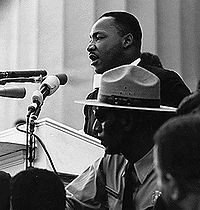 Dr. King's "I Have a Dream" speech, given in front of the Lincoln Memorial during the 1963 March on Washington.
Dr. King's "I Have a Dream" speech, given in front of the Lincoln Memorial during the 1963 March on Washington.
Other sociological issues fueled the growth of the larger counterculture movement. One was an influential nonviolent movement in the United States which resolved Constitutional civil rights illegalities, especially regarding general racial segregation, the lack of voting rights among Southern blacks, and the existing segregation in the purchasing of homes or rental housing in the North.
On college and university campuses, student activists fought for the right to exercise their basic Constitutional rights, especially freedom of speech and freedom of assembly.[19]
Many counterculture activists became newly aware of the ongoing plight of the poor, and community organizers fought for the funding of anti-poverty programs, particularly within inner city areas in the United States.[20][21]
Environmentalism grew from a greater understanding of the ongoing damage caused by industrialization, resultant pollution, and the misguided use of chemicals such as pesticides in well-meaning efforts to improve the quality of life. Authors such as Rachel Carson played key roles in developing a new awareness among the world's population of the fragility of planet earth, despite resistance from elements of the establishment in many countries[22]
The need to address minority rights of women, gays, the handicapped, and many other neglected constituencies within the larger population came to the forefront as an increasing number of primarily younger people broke free from the constraints of 1950s orthodoxy in a desire to create a more inclusive and tolerant social landscape.[23]
The availability of new and more effective forms of birth control was a key underpinning of the sexual revolution. The notion of “recreational sex” without the threat of unwanted pregnancy radically changed the social dynamic and permitted both women and men much greater freedom in the selection of sexual lifestyles outside the confines of traditional marriage.[24] With this change in attitude, by the 1990s the ratio of children born out of wedlock rose from 5% to 25% for Whites and from 25% to 66% for African-Americans.[25]
For those born after World War II, the role of television as a source of entertainment and information, as well as the attendant massive expansion of consumerism afforded by post-war affluence and encouraged by TV advertising, were key components in youthful disillusionment and the formulation of new social behaviours. In America, near-real-time TV news coverage of the civil rights era's Birmingham Campaign, the "Bloody Sunday" event of the Selma to Montgomery marches, and several years of news-footage of the Vietnam War brought bloody confrontations and conflicts into the living rooms for the first time.
The breakdown of enforcement of the American Hays Code concerning censorship in motion picture production, the use of new forms of artistic expression in European and Asian cinema, and the advent of modern production values heralded a new era of European, art-house, pornographic, and American mainstream film production, distribution, and exhibition. This resulted in an almost complete reformation of the western film industry. Likewise, dozens of new film makers across many genres brought previously prohibited subject matter to neighborhood theaters for the first time, even as Hollywood film studios continued to be considered as a part of the establishment by some elements of the counterculture.
Previously disregarded FM radio became a focal point for both music and news for the counterculture generation.[26]
Communes, collectives, and intentional communities regained popularity during this era. Early communities, such as the Hog Farm in the United States and Findhorn in Europe were established as straightforward agrarian attempts to return to the land and live free of interference from outside influences. As the era progressed, many people established and populated new communities in response to not only disillusionment with standard community forms, but also dissatisfaction with certain elements of the counterculture itself. Some of these self-sustaining communities have been credited with the birth and propagation of the international Green Movement. (see also: recycling)
The emergence of an interest in expanded spiritual consciousness, yoga, occult practices and increased human potential helped to shift views on organized religion during the era. In 1957, 69% of Americans polled by Gallup said religion was increasing in influence. By the late 1960s, polls indicated less than 20% still held that belief.[27]
The often violent confrontations between college students (and other activists) and law enforcement officials became one of the hallmarks of the era. Many younger people began to show deep distrust of police, and terms such as “fuzz” and “pig” as derogatory euphemisms for police became part of the counterculture lexicon. This distrust was based not only on fear of police brutality during political protests, but also on generalized police corruption — especially police manufacture of false evidence, and outright entrapment, in drug cases. The social tension between the counterculture and law enforcement reached the breaking point in many notable cases: the Columbia University protests of 1968 in New York City, the 1968 Democratic National Convention protests in Chicago, the arrest and imprisonment of John Sinclair in Ann Arbor, Michigan, and the Kent State shootings incident at Kent State University in Ohio.
The Vietnam War, and the protracted national divide between supporters and opponents of the war, were arguably the most important factors contributing to the rise of the larger counterculture movement. The widely-accepted assertion that anti-war opinion was predominantly held only among the young is a myth,[28][29] but enormous war protests consisting of thousands of mostly younger people in every major American city effectively united the millions of Americans against the war, and against the war policy that prevailed under five congresses and during two presidential administrations.
The era essentially commenced in earnest with the assassination of President John F. Kennedy. It ended with the termination of U.S. combat military involvement in the communist insurgencies of Southeast Asia and the end of the military draft in 1973, and ultimately with the resignation of disgraced President Richard M. Nixon in August, 1974.
Many key movements were born of, or were advanced within, the counterculture of the 1960s. Each movement is relevant to the larger era. The most important stand alone, irrespective of the larger counterculture.[30]
In Europe
The counterculture movement took hold in Western Europe, with London, Amsterdam, Paris and West Berlin rivaling San Francisco and New York as counterculture centers. One manifestation of this was the French general strike that took place in Paris in May 1968, which nearly toppled the French government. Another was the German Student Movement of the 1960s.
In Central Europe, young people adopted the song "San Francisco" as an anthem for freedom, and it was widely played during Czechoslovakia's 1968 "Prague Spring", a premature attempt to break away from Soviet repression. In reaction to Israel's Six-Day War, the Kremlin decided to force Jewish minorities in all Soviet-dominated states to emigrate. This resulted in riots in Warsaw, Poland and several other major cities.
As the newly emergent youth class began to criticize the established social order, new theories about cultural and personal identity began to spread, and traditional non-Western ideas — particularly with regard to religion, social organization and spiritual enlightenment — were more frequently embraced.
In Mexico
In Mexico, rock music was tied into the youth revolt of the 1960s. Cities such as Mexico City, as well as northern cities such as Monterrey, Nuevo Laredo, Ciudad Juárez, and Tijuana, were exposed to American music. Many Mexican rock stars became involved in the counterculture. The three-day Festival Rock y Ruedas de Avándaro, held in 1971, was organized in the valley of Avándaro near the city of Toluca, a town neighboring Mexico City, and became known as "The Mexican Woodstock". Nudity, drug use, and the presence of the American flag scandalized conservative Mexican society to such an extent that the government clamped down on rock and roll performances for the rest of the decade. The festival, marketed as proof of Mexico's modernization, was never expected to attract the masses it did, and the government had to evacuate stranded attendees en masse at the end. This occurred during the era of President Luis Echeverría, an extremely repressive era in Mexican history. Anything that could possibly be connected to the counterculture or student protests was prohibited from being broadcast on public airwaves, with the government fearing a repeat of the student protests of 1968. Few bands survived the prohibition; though the ones that did, like Three Souls in My Mind (now El Tri), remained popular due in part to their adoption of Spanish for their lyrics, but mostly as a result of a dedicated underground following. While Mexican rock groups were eventually able to perform publicly by the mid-1980s, the ban prohibiting tours of Mexico by foreign acts lasted until 1991.
Politics
See also: 1968 protestsCivil Rights Movement
Main article: American Civil Rights Movement (1955-1968)See also: Timeline of the American Civil Rights Movement, Southern Christian Leadership Conference, SNCC, Martin Luther King, Jr., Malcolm X, James Bevel, Diane Nash, Bernard Lafayette, Ralph Abernathy, Sit ins, Freedom Rides, Birmingham Campaign, Selma to Montgomery marches, and Chicago Freedom MovementThe American Civil Rights Movement, a key element of the larger Counterculture movement, involved the use of applied nonviolence to assure that equal rights guaranteed under the U.S. Constitution would apply to all citizens. Many states illegally denied many of these rights to African Americans, and this was successfully addressed in the early and mid-1960s in several major nonviolent movements.
Free Speech Movement
Much of the 1960s counterculture originated on college campuses. The 1964 Free Speech Movement at the University of California, Berkeley, which had its roots in the Civil Rights Movement of the American South, was one early example. At Berkeley a group of students began to identify themselves as having interests as a class that were at odds with the interests and practices of the University and its corporate sponsors. Other rebellious young people, who were not students, also contributed to the Free Speech Movement.[31]
New Left
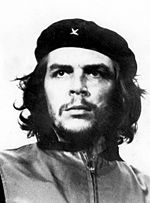 By the late 1960s, revolutionary Che Guevara's famous image had become a popular countercultural symbol of rebellion for many youths.
By the late 1960s, revolutionary Che Guevara's famous image had become a popular countercultural symbol of rebellion for many youths.
The New Left is a term used in different countries to describe left-wing movements that occurred in the 1960s and 1970s. They differed from earlier leftist movements that had been more oriented towards labour activism, and instead adopted social activism. The U.S. "New Left" is associated with college campus mass protests and radical leftist movements. The British "New Left" was an intellectually driven movement which attempted to correct the perceived errors of "Old Left" parties in the post-World War II period. The movements began to wind down in the 1970s, when activists either committed themselves to party projects, developed social justice organizations, moved into identity politics or alternative lifestyles, or became politically inactive.
Anti-War Movement
See also: Students for a Democratic Society (1960 organization), Campaign for Nuclear Disarmament, Free Speech Movement, Vietnam Day Committee, National Coordinating Committee to End the War in Vietnam, Vietnam Veterans Against the War, Abbie Hoffman, Rennie Davis, David Dellinger, Youth International Party, James Bevel, New Zealand's nuclear-free zone, 1968 Democratic National Convention protest activity, Protests of 1968, and Chicago SevenIn Trafalgar Square, London in 1958,[32] in an act of civil disobedience, 60,000–100,000 peace-loving protesters made up of students and pacifists converged in what was to become the “ban the Bomb” demonstrations.[33]
Opposition to the Vietnam War began in 1964 on United States college campuses. Student activism became a dominant theme among the baby boomers, growing to include many Americans. Exemptions and deferments for the middle and upper classes resulted in the induction of a disproportionate number of poor, working-class, and minority registrants. Countercultural books such as MacBird by Barbara Garson and much of the counterculture music encouraged a spirit of non-conformism and anti-establishmentarianism. By 1968, the year after a large march to the United Nations in New York City and a large protest at the Pentagon were undertaken, a majority of Americans opposed the war.[34]
Feminism
Main article: Feminist Movement in the United States (1963–1982)The role of women as full-time homemakers in industrial society was challenged in 1963, when American feminist Betty Friedan published The Feminine Mystique, giving momentum to the women's movement and influencing what many called Second-wave feminism. Other activists, such as Gloria Steinem and Angela Davis, either organized, influenced, or educated many of a younger generation of women to endorse and expand feminist thought.
Environmentalism
Counterculture environmentalists were quick to grasp the early (i.e., 1970s) analyses of the reality and the import of the Hubbert "peak oil" prediction. More broadly they saw that the dilemmas of energy derivation would have implications for geo-politics, lifestyle, environment, and other dimensions of modern life.
Gay Liberation Movement
The Stonewall riots were a series of spontaneous, violent demonstrations against a police raid that took place in the early morning hours of June 28, 1969, at the Stonewall Inn, a gay bar in the Greenwich Village neighborhood of New York City. This is frequently cited as the first instance in American history when people in the homosexual community fought back against a government-sponsored system that persecuted sexual minorities, and became the defining event that marked the start of the Gay Rights Movement in the United States and around the world.
Culture
Hippies
Main article: HippiesAfter the January 14, 1967 Human Be-In in San Francisco organized by artist Michael Bowen, the media's attention on the counterculture was fully activated.[35] In 1967 Scott McKenzie's rendition of the song "San Francisco (Be Sure to Wear Flowers in Your Hair)" brought as many as 100,000 young people from all over the world to celebrate San Francisco's "Summer of Love."
While the song had originally been written by John Phillips of The Mamas & the Papas to promote the June 1967 Monterey Pop Festival, it became an instant hit worldwide (#4 in the United States, #1 in Europe) and quickly transcended its original purpose.
San Francisco's flower children, also called "hippies" by local newspaper columnist Herb Caen, adopted new styles of dress, experimented with psychedelic drugs, lived communally and developed a vibrant music scene. When people returned home from "The Summer of Love" these styles and behaviors spread quickly from San Francisco and Berkeley to many U.S. and Canadian cities and European capitals. Some hippies formed communes to live as far outside of the established system as possible. This aspect of the counterculture rejected active political engagement with the mainstream and, following the dictate of Timothy Leary to "Turn on, tune in, drop out", hoped to change society by dropping out of it. Looking back on his own life (as a Harvard professor) prior to 1960, Leary interpreted it to have been that of "an anonymous institutional employee who drove to work each morning in a long line of commuter cars and drove home each night and drank martinis .... like several million middle-class, liberal, intellectual robots."
As members of the hippie movement grew older and moderated their lives and their views, and especially after US involvement in the Vietnam War ended in the mid-1970s, the counterculture was largely absorbed by the mainstream, leaving a lasting impact on philosophy, morality, music, art, alternative health and diet, lifestyle and fashion.
Marijuana, LSD, and other recreational drugs
During the 1960s, this second 'group' of casual LSD users evolved and expanded into a subculture that extolled the mystical and religious symbolism often engendered by the drug's powerful effects, and advocated its use as a method of raising consciousness. The personalities associated with the subculture, gurus such as Dr. Timothy Leary and psychedelic rock musicians such as the Grateful Dead, Jimi Hendrix, Jefferson Airplane and The Beatles soon attracted a great deal of publicity, generating further interest in LSD.
The popularization of LSD outside of the medical world was hastened when individuals such as Ken Kesey participated in drug trials and liked what they saw. Tom Wolfe wrote a widely read account of these early days of LSD's entrance into the non-academic world in his book The Electric Kool Aid Acid Test, which documented the cross-country, acid-fueled voyage of Ken Kesey and the Merry Pranksters on the psychedelic bus "Furthur" and the Pranksters' later 'Acid Test' LSD parties.
In 1965, Sandoz laboratories stopped its still legal shipments of LSD to the United States for research and psychiatric use, after a request from the U.S. government concerned about its use.
By April 1966, LSD use had become so widespread that Time Magazine warned about its dangers.[36]
In December 1966, the exploitation film Hallucination Generation was released.[37] This was followed by The Trip (film) in 1967 and Psych-Out in 1968.
Ken Kesey and the Merry Pranksters
Ken Kesey and his Merry Pranksters helped shape the developing character of the 1960s counterculture when they embarked on a cross-country voyage during the summer of 1964 in a psychedelic school bus named "Furthur." Beginning in 1959, Kesey had volunteered as a research subject for medical trials financed by the CIA's MK ULTRA project. These trials tested the effects of LSD, psilocybin, mescaline, and other psychedelic drugs. After the medical trials, Kesey continued experimenting on his own, and involved many close friends; collectively they became known as "The Merry Pranksters." The Pranksters visited Harvard LSD proponent Timothy Leary at his Millbrook, New York retreat, and experimentation with LSD and other psychedelic drugs, primarily as a means for internal reflection and personal growth, became a constant during the Prankster trip.
The Pranksters created a direct link between the 1950s Beat Generation and the 1960s psychedelic scene; the bus was driven by Beat icon Neal Cassady, Beat poet Allen Ginsberg was onboard for a time, and they dropped in on Cassady's friend, Beat author Jack Kerouac — though Kerouac declined to participate in the Prankster scene. After the Pranksters returned to California, they popularized the use of LSD at so-called "Acid Tests", which initially were held at Kesey's home in La Honda, California, and then at many other West Coast venues.
Other Psychedelics
Experimentation with LSD, mescaline, peyote, sacred mushrooms, and other psychedelic drugs became a major component of 1960s counterculture, influencing philosophy, art, music and styles of dress.
Sexual revolution
Beginning in San Francisco in the mid 1960s, a new culture of "free love" arose, with millions of young people embracing the hippie ethos and preaching the power of love and the beauty of sex as a natural part of ordinary life. By the start of the 1970s it was acceptable for colleges to allow co-educational housing where male and female students mingled freely. This aspect of the counterculture continues to impact modern society.
Alternative media
Underground newspapers sprang up in most cities and college towns, serving to define and communicate the range of phenomena that defined the counterculture: radical political opposition to "The Establishment", colorful experimental (and often explicitly drug-influenced) approaches to art, music and cinema, and uninhibited indulgence in sex and drugs as a symbol of freedom. The papers also often included comic strips, from which the underground comix were an outgrowth.
Avant-garde art and anti-art
The Situationist International was a restricted group of international revolutionaries founded in 1957, and which had its peak in its influence on the unprecedented general wildcat strikes of May 1968 in France. With their ideas rooted in Marxism and the 20th-century European artistic avant-gardes, they advocated experiences of life being alternative to those admitted by the capitalist order, for the fulfillment of human primitive desires and the pursuing of a superior passional quality. For this purpose they suggested and experimented with the construction of situations, namely the setting up of environments favorable for the fulfillment of such desires. Using methods drawn from the arts, they developed a series of experimental fields of study for the construction of such situations, like unitary urbanism and psychogeography. They fought against the main obstacle on the fulfillment of such superior passional living, identified by them in advanced capitalism. Their theoretical work peaked on the highly influential book The Society of the Spectacle by Guy Debord. Debord argued in 1967 that spectacular features like mass media and advertising have a central role in an advanced capitalist society, which is to show a fake reality in order to mask the real capitalist degradation of human life.
Fluxus — a name taken from a Latin word meaning "to flow" — is an international network of artists, composers and designers noted for blending different artistic media and disciplines in the 1960s. They have been active in Neo-Dada noise music and visual art as well as literature, urban planning, architecture, and design. Fluxus is often described as intermedia, a term coined by Fluxus artist Dick Higgins in a famous 1966 essay. Fluxus encouraged a "do-it-yourself" aesthetic, and valued simplicity over complexity. Like Dada before it, Fluxus included a strong current of anti-commercialism and an anti-art sensibility, disparaging the conventional market-driven art world in favor of an artist-centered creative practice. As Fluxus artist Robert Filliou wrote, however, Fluxus differed from Dada in its richer set of aspirations, and the positive social and communitarian aspirations of Fluxus far outweighed the anti-art tendency that also marked the group.
In the 1960s, the Dada-influenced art group Black Mask declared that revolutionary art should be "an integral part of life, as in primitive society, and not an appendage to wealth."[38] Black Mask disrupted cultural events in New York by giving made up flyers of art events to the homeless with the lure of free drinks.[39] After, the Motherfuckers grew out of a combination of Black Mask and another group called Angry Arts. Up Against the Wall Motherfuckers (often referred to as simply "the Motherfuckers", or UAW/MF) was an anarchist affinity group based in New York City. This "street gang with analysis" was famous for its Lower East Side direct action and is said to have inspired members of the Weather Underground and the Hippies.
Music
"The 60′s were a leap in human consciousness. Mahatma Gandhi, Malcolm X, Martin Luther King, Che Guevara, Mother Teresa, they led a revolution of conscience. The Beatles, The Doors, Jimi Hendrix created revolution and evolution themes. The music was like Dali, with many colors and revolutionary ways. The youth of today must go there to find themselves."
During the early 1960s, Britain's new wave of musicians gained popularity and fame in the United States. Artists such as The Beatles paved the way for their compatriots to enter the U.S. market.[41] The Beatles themselves were influenced by many artists, among them American singer/songwriter Bob Dylan, who was a lyrical inspiration as well as their introduction to marijuana.[42] Dylan’s early career as a protest singer had been inspired by artists like Pete Seeger[43] and his hero Woody Guthrie[44] Other folksingers like Joan Baez and Peter, Paul and Mary took the songs of the era to new audiences and public recognition.[45]
The music of the 1960s moved towards an electric, psychedelic version of rock. Thanks largely to Bob Dylan’s decision to play an electric guitar at the 1965 Newport Folk Festival.[46] The newly popularized electric sound of rock was then built upon and molded into psychedelic rock by artists like The 13th Floor Elevators[47] and British bands Pink Floyd and the Beatles.[48] The Beach Boys’ 1966 album Pet Sounds also paved the way for later hippie acts, with Brian Wilson’s writing interpreted as a “plea for love and understanding.”[49] Pet Sounds served as a major source of inspiration for other contemporary acts, most notably directly inspiring The Beatles' Sgt. Pepper's Lonely Hearts Club Band. The single Good Vibrations soared to number one globally, completely changing the perception of what a record could be. It was during this period that the highly anticipated album Smile was to be released. However the project collapsed and The Beach Boys released a downgraded version called Smiley Smile, which failed to make a big commercial impact but was also highly influential, most notably on The Who's Pete Townshend.
The Beatles went on to become the most prominent commercial exponents of the "psychedelic revolution" (e.g., Rubber Soul, Revolver, Sgt. Pepper's Lonely Hearts Club Band and Magical Mystery Tour) in the late 1960s.[50] Meanwhile in the United States, bands that exemplified the counterculture were becoming huge commercial, mainstream successes. These included The Mamas & the Papas (If You Can Believe Your Eyes and Ears), Big Brother and the Holding Company (Cheap Thrills), Jimi Hendrix (Are You Experienced?), Jefferson Airplane (Surrealistic Pillow), The Doors and Sly and the Family Stone (Stand!).[51] Bands and other musicians, such as The Grateful Dead, Phil Ochs, Quicksilver Messenger Service, Melanie, Frank Zappa, Santana, and the Blues Project did not achieve such commercial success but are considered key to the counterculture movement.
While the hippie scene was born in California,[52] an edgier scene emerged in New York City[53] that put more emphasis on avant-garde and art music. Bands such as The Velvet Underground came out of this underground music scene, predominantly centered at Andy Warhol's legendary Factory. The Velvet Underground supplied the music for the Exploding Plastic Inevitable, a series of multi-media events staged by Warhol and his collaborators in 1966 and 1967. The Velvet Underground's lyrics were considered risque for the era, since they discussed sexual fetishism, transgender identities, and the use of drugs associated with Warhol's Factory and its superstars.[54]
Detroit's MC5 also came out of the underground rock music scene of the late 1960s. They introduced a more aggressive evolution of garage rock which was often fused with sociopolitical and countercultural lyrics of the era, such as in the song "Motor City Is Burning" (a John Lee Hooker cover adapting the story of the Detroit Race Riot of 1943 to the Detroit riot of 1967). They had ties to radical leftist organizations such as "Up Against the Wall Motherfuckers" and John Sinclair's White Panther Party[55] MC5 performed a lengthy set before the 1968 Democratic National Convention in Chicago, where an infamous riot subsequently broke out between police and students protesting the Vietnam War and the recent assassinations of Martin Luther King, Jr. and Robert Kennedy[56] MC5, The Stooges, and the aforementioned Velvet Underground, are now seen as an influence on the protopunk sound that would lead to punk rock in the late 1970s.[57]
The counterculture was the era of the festival. The Monterey Pop Festival, which launched Jimi Hendrix's career in America was the first of these.[58] Britain’s 1968–1970 Isle of Wight Festivals drew big names such as The Who, The Doors, Joni Mitchell, Hendrix, Dylan, and others.[59] The 1969 Woodstock Festival in New York became a symbol of the hippie movement, although the 1970 Isle of Wight Festival drew a larger crowd.[60] However the era came to an abrupt end with the infamous Altamont Free Concert held by The Rolling Stones in which heavy-handed security from the Hells Angels resulted in the stabbing of an audience member as the show descended into chaos.[61]
As the psychedelic revolution progressed, lyrics grew more complex, (such as Jefferson Airplane's "White Rabbit"[62]). Long-playing albums enabled artists to make more in-depth statements than could be made in a single song (such as the Mothers of Invention's satirical Freak Out![63]). Even the rules governing single songs were stretched: singles lasting longer than three minutes emerged, such as Dylan's "Like a Rolling Stone," Arlo Guthrie's "Alice's Restaurant," and Iron Butterfly's 17-minute long "In-A-Gadda-Da-Vida.".[46]
The 1960s saw the protest song gain a sense of political self importance, with Phil Ochs's "I Ain't Marching Anymore" and Country Joe and the Fish's "I-Feel-Like-I'm-Fixin'-to-Die-Rag" among the many anti-war anthems that were important to the era.[60]
Film
The Counterculture Revolution was affected by cinema. Films like Bonnie and Clyde struck a chord with the youth as “the alienation of the young in the 1960s was comparable to the director's image of the 1930s”.[64] Films of this time also focused on the changes happening in the world. Dennis Hopper's Easy Rider (1969) focused on the counterculture of the time.[65] Medium Cool portrayed the 1968 Democratic Convention alongside the 1968 Chicago police riots which has led to it being labeled as “a fusion of cinema-vérité and political radicalism”.[66] One film-studio attempt to cash in on the hippie trend was 1968's Psych-Out,[67] which is in contrast to the film version of Arlo Guthrie's Alice's Restaurant which some say portrayed the generation as “doomed”.[68] The music of the era was represented by films such as 1970's Woodstock, a documentary of the music festival.[69]
In France the New Wave was a blanket term coined by critics for a group of French filmmakers of the late 1950s and 1960s, influenced by Italian Neorealism and classical Hollywood cinema. Although never a formally organized movement, the New Wave filmmakers were linked by their self-conscious rejection of classical cinematic form and their spirit of youthful iconoclasm and is an example of European art cinema.[70] Many also engaged in their work with the social and political upheavals of the era, making their radical experiments with editing, visual style and narrative part of a general break with the conservative paradigm.
Technology
In his 1986 essay "From Satori to Silicon Valley",[71] cultural historian Theodore Roszak pointed out that Apple Computer emerged from within the West Coast counterculture. Roszak outlines the Apple computer's development, and the evolution of 'the two Steves' (Steve Wozniak and Steve Jobs, the Apple's developers) into businessmen. Like them, many early computing and networking pioneers — after discovering LSD and roaming the campuses of UC Berkeley, Stanford, and MIT in the late '60s and early '70s — would emerge from this caste of social "misfits" to shape the modern world.
Legacy
The legacy of the Counterculture is still actively contested in debates that are sometimes framed, in the U.S., in terms of a "culture war". Jay Walljasper, a commentator and the editor of Utne Reader — though not himself from the so-called '60s Generation — has written: "From the great gyrations of the counterculture would come a movement dedicated to the greening of America. While many once-ardent advocates of radical ideas now live in the suburbs and vote Republican, others have held fast to the dream of creating a new kind of American society and they've been joined by fresh streams of younger idealists."[cite this quote] In the UK, commentator Peter Hitchens identifies the Counterculture as one of the contributing factors to what he sees as the current malaise in British politics.[72]
Sources
- Jentri Anders, Beyond Counterculture, Washington State University Press, 1990, ISBN 978-0-87422-060-5 & ISBN 978-0-87422-060-5
- Theodore Roszak (1968) The Making of a Counter Culture
- Rachel Carson Silent Spring Fawcett Crest, 1964, ISBN 978-0-449-20079-7
- Charles A. Reich (1970) The Greening of America, 25th anniversary edition, Three Rivers Press, 1995. ISBN 978-0-517-88636-6
- Rebecca Jackson, Iowa State University Library, The 1960s: A Bibliography. <http://www.public.iastate.edu/~rjackson/webbibl.html>
References
- ^ Hirsch, E.D. (1993). The Dictionary of Cultural Literacy. Houghton Mifflin. ISBN 978-0-395-65597-9. p 419. "Members of a cultural protest that began in the U.S. in the 1960s and affected Europe before fading in the 1970s...fundamentally a cultural rather than a political protest."
- ^ "Rockin' At the Red Dog: The Dawn of Psychedelic Rock," Mary Works Covington, 2005.
- ^ Anderson, Terry H. (1995). The Movement and the Sixties. Oxford University Press. ISBN 978-0-19-510457-8.
- ^ Jentri Anders, Beyond Counterculture, Washington State University Press, 1990, ISBN 978-0-87422-060-5 & ISBN 978-0-87422-060-5
- ^ "The Cold War Museum - Museum Features". Coldwar.org. 1960-05-01. http://www.coldwar.org/museum/museum_features.html. Retrieved 2009-07-11.[dead link]
- ^ "Port Huron Statement of the Students for a Democratic Society, 1962". Coursesa.matrix.msu.edu. http://coursesa.matrix.msu.edu/~hst306/documents/huron.html. Retrieved 2009-07-11.
- ^ "Washington Bulletin on NRO". Nationalreview.com. 1970-01-01. http://www.nationalreview.com/daily/nr110100.shtml. Retrieved 2009-07-11.
- ^ John Pike. "Nuclear Weapons - Iraq Special Weapons". Globalsecurity.org. http://www.globalsecurity.org/wmd/world/iraq/nuke.htm. Retrieved 2009-07-11.
- ^ Frum, David (2000). How We Got Here: The '70s. New York, New York: Basic Books. p. 27. ISBN 978-0-465-04195-4
- ^ "Avalon Project - The U-2 Incident 1960". Avalon.law.yale.edu. http://avalon.law.yale.edu/20th_century/u2.asp. Retrieved 2009-07-11.
- ^ "Page 1: 1963-77 Limits on Nuclear Testing and the Treaty on the Non-Proliferation of Nuclear Weapons: CTBTO Preparatory Commission". Ctbto.org. http://www.ctbto.org/the-treaty/history-1945-1993/1963-77limits-on-nuclear-testing/page-1-1963-77limits-on-nuclear-testingand-the-treaty-on-the-non-proliferation-of-nuclear-weapons/. Retrieved 2009-07-11.
- ^ Friday, Aug. 30, 1963 (1963-08-30). "Of Treaties & Togas". TIME. http://www.time.com/time/magazine/article/0,9171,940699,00.html?promoid=googlep. Retrieved 2009-07-11.
- ^ http://womenincongress.house.gov/educational/essay3.pdf
- ^ "1967 Executive Sessions of the Senate Foreign Relations Committee". Fas.org. http://www.fas.org/irp/congress/2007_hr/1967executive.html. Retrieved 2009-07-11.
- ^ George F. Kennan, American Diplomacy, 1900-1950, Charles R. Walgreen Foundation Lectures, Mentor Books, New York, 1951, pp. 82-89
- ^ "American Experience | Oswald's Ghost". PBS. 1963-11-22. http://www.pbs.org/wgbh/amex/oswald/program/pt.html. Retrieved 2009-07-11.
- ^ "Baby Boom population - U.S. Census Bureau - USA and by state". Boomerslife.org. http://www.boomerslife.org/baby_boom_population_us_census_bureau_by_state.htm. Retrieved 2009-06-09.
- ^ "National Survey on Drug Use and Health (NSDUH) Series". Icpsr.umich.edu. http://www.icpsr.umich.edu/cocoon/SAMHDA/SERIES/00064.xml. Retrieved 2009-06-09.
- ^ Elizabeth Stephens. "Free Speech Movement Chronology". Bancroft.berkeley.edu. http://bancroft.berkeley.edu/FSM/chron.html. Retrieved 2009-06-09.
- ^ "A Brief History of CO". Nfg.org. http://www.nfg.org/cotb/09historyco.htm. Retrieved 2009-07-11.[dead link]
- ^ "The Historical Development of Community Organizing". Trincoll.edu. http://www.trincoll.edu/depts/tcn/valocchi.htm. Retrieved 2009-07-11.
- ^ "U.S. Technology and Environment Historiography". H-net.org. http://www.h-net.org/~environ/historiography/ustechnology.htm. Retrieved 2009-07-11.
- ^ Skrentny, John (2002). The Minority Rights Revolution. Cambridge: The Belknap Press of Harvard University Press, 2002. ISBN 978-0-674-00899-1
- ^ "American Experience | The Pill". Pbs.org. http://www.pbs.org/wgbh/amex/pill/. Retrieved 2009-06-09.
- ^ "Determinants of Planned and Unplanned Childbearing among Unmarried Women in the United States" (PDF). http://www.ssc.wisc.edu/cde/cdewp/99-09.pdf. Retrieved 2009-07-11.
- ^ Sterling, Christopher & Keith, Michael (2008). Sounds of Change: A History of FM Broadcasting in America. UNC Press. ISBN 978-0-8078-3215-8
- ^ http://www.gallup.com/poll/103459/Questions-Answers-About-Americans-Religion.aspx#
- ^ "Support for Vietnam War". Seanet.com. 2002-11-21. http://www.seanet.com/~jimxc/Politics/Mistakes/Vietnam_support.html. Retrieved 2009-06-09.
- ^ "Generations Divide Over Military Action in Iraq - Pew Research Center for the People & the Press". People-press.org. 2002-10-17. http://people-press.org/commentary/?analysisid=57. Retrieved 2009-06-09.
- ^ Anderson, Terry H. The movement and the sixties. New York: Oxford University Press, 1995.
- ^ "Free Speech Movement Archives Home Page - events from 1964 and beyond". FSM-A. http://www.fsm-a.org/. Retrieved 2009-06-09.
- ^ "Why I'm back to ban the bomb". BBC News. 2004-04-11. http://news.bbc.co.uk/2/hi/uk_news/england/berkshire/3592623.stm.
- ^ "1960: Thousands protest against H-bomb". BBC News. 1960-04-18. http://news.bbc.co.uk/onthisday/hi/dates/stories/april/18/newsid_2909000/2909881.stm.
- ^ Gallup, Alec; Frank Newport. The Gallup Poll: Public Opinion 2005. Rowman & Littlefield. pp. 315–318. ISBN 978-0-7425-5258-6.
- ^ Martin A. Lee, Acid Dreams The CIA, LSD, and the Sixties Rebellion, Grove Press 1985, Pgs. 157-163 ISBN 978-0-394-62081-7
- ^ Friday, Apr. 22, 1966 (1966-04-22). "Drugs: The Dangers of LSD". TIME. http://www.time.com/time/magazine/article/0,9171,899158,00.html. Retrieved 2010-04-20.
- ^ http://www.imdb.com/title/tt0060488/
- ^ Hinderer, Eve. Ben Morea: art and anarchism
- ^ Stewart Home. "The Assault on Culture: Utopian currents from Lettrisme to Class War". Introduction to the Lithuanian edition. (Ist edition Aporia Press and Unpopular Books, London 1988.) ISBN 978-0-948518-88-1. "In the sixties Black Mask disrupted reified cultural events in New York by making up flyers giving the dates, times and location of art events and giving these out to the homeless with the lure of the free drink that was on offer to the bourgeoisie rather than the lumpen proletariat; I reused the ruse just as effectively in London in the 1990s to disrupt literary events."
- ^ Carlos Santana: I’m Immortal interview by Punto Digital, October 13, 2010
- ^ R. Shuker, 1998, p. 34
- ^ P. Brown and S. Gaines, 1984, p. 134
- ^ J. Cott, 2007, p. 376
- ^ P. Dogget, 2007, p. 25
- ^ A. J. Matusow, 1984, p. 295
- ^ a b H. Sounes, 2002, p. 218
- ^ M. C. Strong, 1997, p. 276
- ^ Shuker, 1998, p. 234
- ^ J. Derogatis, 1996, p. 19
- ^ Posted Nov 01, 2003 12:00 AM (2003-11-01). "1) Sgt. Pepper's Lonely Hearts Club Band". Rolling Stone. http://www.rollingstone.com/news/story/6595610/1_sgt_peppers_lonely_hearts_club_band. Retrieved 2009-06-09.
- ^ M. C. Strong, 2002
- ^ Shuker, 1998, p. 72
- ^ B. Longhurst, 1995, p. 108
- ^ Derogatis, 1996, p. 44
- ^ Dogget, 2007, p. 117
- ^ D. Snowman, 1978, p. 155
- ^ Shuker, 1998, p. 237
- ^ Derogatis, 1996, p. 95
- ^ Sounes, 2002, p. 296
- ^ a b Dogget, 2007, p. 58
- ^ Matusow, 1986, p. 305
- ^ Matusow, 1986, p. 297
- ^ Strong, 1997, p. 317
- ^ M. A. Jackson and J. E. O’Connor, 1980, P237
- ^ P. Biskind, 1999, P74
- ^ J. Pym, 2002, P741
- ^ J. Pym, 2002, P932
- ^ J. Hoberman, 2003, P237
- ^ P. Biskind, 1999, P150
- ^ http://www.brynmawrfilm.org/08_French_Cinema_NEW.html
- ^ "From Satori to Silicon Valley" - Roszak, Stanford
- ^ Hitchens, Peter (2009). The Broken Compass: How British Politics Lost its Way. Continuum International Publishing Group Ltd.. ISBN 978-1-84706-405-9. — see conclusion, 'The Broken Compass'
External links
- Counterculture Wiki
- Island Foundation
- John Hoyland, Power to the People, The Guardian, 15 March 2008
Recreational drug use Major recreational drugs Amphetamine · Arecoline (Areca) · Betel · Caffeine (Coffee · Tea) · Cathinone (Khat) · Cocaine (Coca) · Ephedrine (Ephedra) · Mephedrone · Methamphetamine · Methylphenidate · Nicotine (Tobacco) · Theobromine (Cocoa)EntactogensHallucinogensBufotenin ( Psychoactive toads · Vilca · Yopo) · DMT (Ayahuasca) · LSA · LSD-25 · Mescaline (Peruvian Torch · Peyote · San Pedro) · Psilocybin / Psilocin (Psilocybin mushrooms)DXM · Inhalants (Nitrous oxide · alkyl nitrites – poppers, such as amyl nitrite) · Ketamine · Methoxetamine · Muscimol (Amanita muscaria) · PCP · Salvinorin A (Salvia divinorum)Atropine and Scopolamine (Datura · Deadly Nightshade · Henbane · Mandrake) · Dimenhydrinate · DiphenhydramineCannabinoids
Drug subculture 420 · Cannabis cultivation · Cannabis smoking · Legal history of cannabis in the United States · Legality of cannabis · Marijuana Policy Project · Medical cannabis · NORML · Religious and spiritual use of cannabis · Stoner filmOtherClub drug · Counterculture of the 1960s · Dance party · Drug paraphernalia · Drug tourism · Entheogen · Hippie · Party and play · Poly drug use · Rave · Self-medication · Sex and drugsProblems with drug use Abuse · Dependence (Prevention · Opioid replacement therapy · Rehabilitation · Responsible use) · Drug-related crime · Fetal alcohol spectrum disorder · Illegal drug trade · Long-term effects of cannabis · Neurotoxicity · OverdoseLegality of drug use InternationalState levelDrug policy
by countryAustralia · Canada · Germany · Netherlands · Portugal · Sweden · Switzerland · Soviet Union · United States (Just Say No · Office of National Drug Control Policy · School district drug policies · California · Colorado · Maryland · Virginia)OtherLists of countries by... Alcohol consumption · Cannabis legality (Annual use · Lifetime use) · Cigarette consumption · Cocaine use · Opiates useHippies History Etymology of 'hippie' · Beat generation/Beatniks · Counterculture of the 1960s · Human Be-In · Red Dog Experience · San Francisco Sound · Haight-Ashbury · Drop City · Summer of Love · Monterey Pop Festival · The Farm · Woodstock Festival · La Onda · Nambassa · Glastonbury FestivalPeople and groups Ken Kesey and the Merry Pranksters · Diggers · San Francisco Oracle · Haight Ashbury Free Clinics · Haight-Ashbury Switchboard · Yippies · The Brotherhood of Eternal Love · Jesus movement · Rainbow Family · Deadhead · New Age travellers · Radical FaeriesPolitics and ethics Free love · Anti-authoritarianism · Simple living · Environmentalism · Pacifism · Communalism · Counterculture · Bohemianism · Make love, not war · Turn on, tune in, drop out · VegetarianismCulture and fashion Psychedelia · Flower power · Hippie trail · Happening · Peace symbols · Bell-bottoms · Long hair · Tie-dye · Intentional community · Free festival · Music festival · Flower child · List of films related to the hippie subculture · List of books and publications related to the hippie subcultureMusic Folk rock · Psychedelic rock · Folk music · Psychedelic folk · Progressive rock · Jam bands · Psychedelic trance · Psychedelic music · World music · New Age music · Space rockRelated subjects Original defendants Other related individuals Categories:- Counterculture of the 1960s
- Anti-war protests
- 1960s in music
- Sexual revolution
Wikimedia Foundation. 2010.

